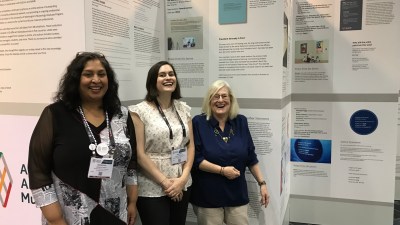
Museums make their communities better, stronger, and more resilient in myriad ways. Some of these are directly related to their missions: enriching local education, improving health and well-being via arts engagement, providing context from history and science that helps citizens to make informed decisions. But museums are also incredible resources simply by virtue of the operational resources they amass—space, equipment, skills, expertise, connections. In the current era of rising risk, museums’ resources can be a vital part of a community’s capacity to respond to emergencies such as heat, flood, fire, storm, and civil unrest. Today on the blog, Chief Operating Officer ZeeAnn Mason tells us how the Museum of the American Revolution stepped up to help neighbors in need in the wake of disaster.
–Elizabeth Merritt, Vice President, Strategic Foresight and Founding Director, Center for the Future of Museums, American Alliance of Museums
As a new museum in 2018, we at the Museum of the American Revolution—home to General George Washington’s War Tent—had yet to celebrate our first Presidents’ Day weekend. We were pulling out all the stops for the February 17-19 weekend with special programming and events. On Saturday, we were pleased to welcome over 2,000 guests. Sunday was anticipated to be an even bigger day, with a sold-out brunch featuring a costumed George Washington interpreter. Little could we have imagined that instead of serving visitors, we would be serving our community that day.
At 3:13 a.m. on Sunday, a fire broke out across the street from the Museum’s location in historic Philadelphia. Apartment dwellers and hotel guests evacuated the buildings across the street in their night clothes. It was a cold night. The fire raged, growing to two, three and four alarms. More people were evacuated as the fire escalated. Miraculously, the Museum was unscathed. City busses were brought in to keep people warm.
Staff security notified our operations team who rushed to the scene. A call came from the fire chief—could we open the museum to house those who were evacuated? There was no question or discussion—of course. Staff led roughly 60 displaced neighbors to our classrooms. We could offer warmth, restrooms, and water. Soon we were able to offer more.
Our catering team had somehow managed to arrive on-site despite the nearly impassable streets that were clogged with emergency vehicles. They were preparing the sumptuous brunch for the 85 registered guests. By 7am, with the fire intensifying, it became clear we would not be opening to the public that day. What better use of that delicious food than to offer it to our evacuated neighbors? They were surprised, delighted, grateful.
Firefighters battled the fire for more than nine hours, declaring the fire under control – but not yet out – at 12:23 p.m. No injuries were reported. Said Noelle Foizen, deputy director of the city’s Office of Emergency Management. “It was a rager, so they were really fortunate that they got everyone out.”
On Tuesday, we were offered another opportunity to help our neighbors when we received a call from staff from the hotel across the street. Their building had suffered extensive smoke and water damage and would be closed indefinitely. They wondered if we could provide office space and telephones for their sales team so they could begin contacting and cancelling more than 800 bookings. Among the more difficult calls they needed to make were to the brides whose weddings were planned for the coming weeks. We were happy to set them up in a spacious office to do their work and heartened to learn how the local hotel community responded with generous offers to help, often greatly reducing their rates to match what the client had been contracted to pay.
Over the ensuing months and years, as demolition, rebuilding, and the investigation into the cause of the fire ensued, we were happy to offer meeting space for fire, police, staff from license and inspections and emergency management. We collected donations from our guests who were eager to assist the displaced residents.
Just this year, the cause of the fire was made known. We were pleased that footage from our external security cameras became critical evidence that enabled the authorities to pin down the time of the fire and how and where the initial explosion occurred. It also captured footage of a passer-by who was ultimately charged with arson.
The aftermath of the fire continues to this day. Several businesses never recovered, and tenants have yet to return to their apartments. The hotel is scheduled to reopen in early 2022.
Our museum is the newest addition to this historic block. We were honored – at a moment of crisis—to be able to contribute to our community in such a meaningful way—not as a cultural institution, but as a neighbor, doing what we could for other neighbors in need.
Skip over related stories to continue reading articleZeeAnn Mason is Chief Operating Officer of the Museum of the American Revolution. She joined the organization in its formative years (2002) as its second staff member, and has been involved in all aspects of planning, opening, and operating the 118,000 square-foot, LEED Gold-certified museum that opened on time and under budget in April 2017. This month, the museum is preparing to welcome its millionth visitor. To learn more about the museum, visit www.AmRevMuseum.org or connect on Facebook, Instagram, and Twitter at @AmRevMuseum.








Comments